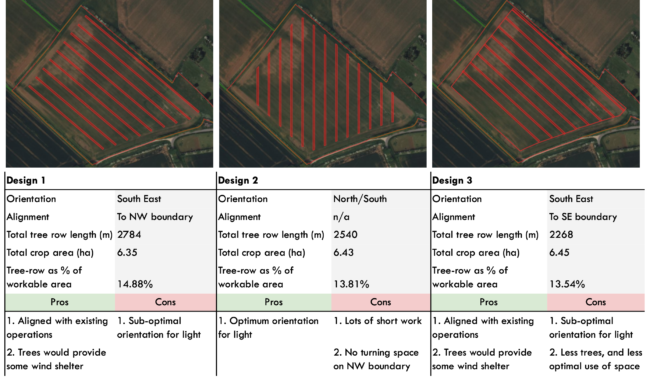Whole farm agroforestry design
Several agroforestry systems were designed for this estate as part of their effort to diversity food production and increase habitat connectivity. Systems include: traditional cider orchard on contour lines, intensive and extensive fruit and nut silvohorticulture alley cropping, silvopasture biomass alley cropping for woodchip, riparian woodland extension, and a shelterbelt woodland.
Key Design Features
- Diversity of fruit varieties and rootstocks to offer sustained yields over time
- Extensive alley cropping designed to allow additional tree lines to be added in the future
- Traditional orchard designed to allow for understory grazing
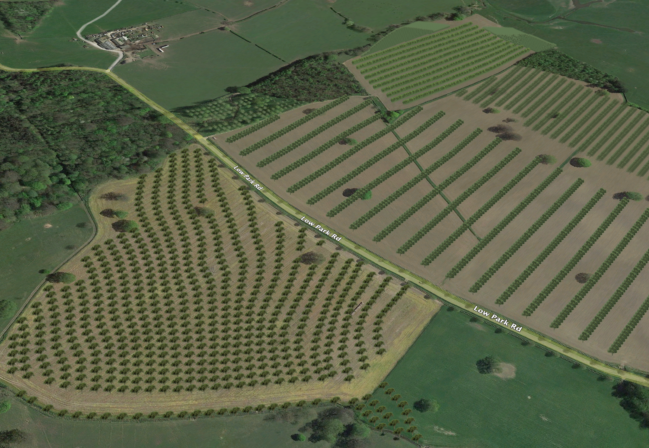

Top image: 3D model of design from north-west angle
Bottom image: Birds eye view of design with features labelled
Silvoarable Walnut Alley Cropping
This design features five varieties of walnut interplanted with eleagnus, common alder, and silver birch. These nurse trees were selected in partnership with the University of Reading to test the effect of nitrogen fixation from eleagnus and common alder on walnut productivity in agroforestry. Silver birch included as a control.
Key Design Features
- 36m cropping alley for regenerative arable
- 3m tree row with trees at 1m spacing
- Nurse trees to be thinned as walnuts mature providing fire-wood harvest
- Additional rows of native broadleaf mixtures also included for biodiversity provision
- Trees planted on 4% of 25ha field
(Bottom photo credit: Andrew Mahon | Bromborough Estate)


Top image: digital design of silvoarable system
Bottom image: Tree rows prepared for planting (Credit: Andrew Mahon)
Stone Pine & Blueberry Intercropping
Innovative shade-grown blueberry system with stone pine trees offering canopy cover and pine nuts as part of a new regenerative farm in Portugal.
Key Design Features
- 12x12m quincunx grid planting of stone pine
- 15 blueberry plants between each stone pine
- Stone pine at 141/ha
- Blueberries at 4223/ha
- All plants to be irrigated

Silvoarable & Silvopastoral Alley Cropping
Three mixes of broadleaf natives and hybrid biomass willow and poplar planted in single rows to provide shelter for sheep and cattle that graze on herbal leys as part of FarmED's 8-year arable rotation.
Key Design Features
- 32m cropping alley
- 3m tree row with trees at 1m spacing
- Multi-purpose semi-permenant 4-strand electric fencing for mob-grazing and tree protection
- 2500 trees planted in six days with 100 volunteers
- Tree will be coppiced for woodchip
(Photo credit: James Mountain | FarmED)
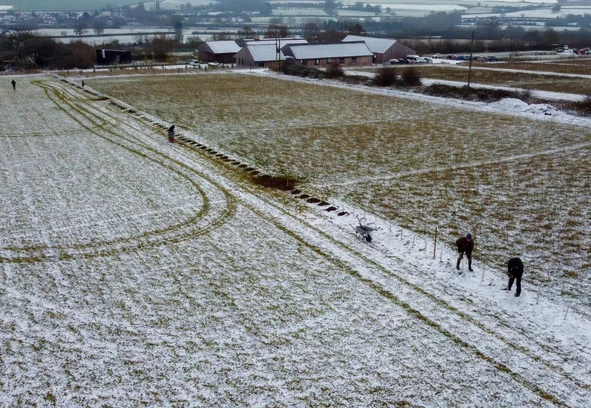
Mixture 1: Hybrid Willow & Poplar
Mixture 2: Sweet Chestnut, Goat Willow, Osier Willow, Black Poplar
Mixture 3: Hazel, Wych Elm, Common Alder, Rowan, Field Maple, Sycamore
Silvohorticulture Alleycropping
Working with the Kitchen Garden People, a community supported agriculture business, I led a participatory design process to integrate fruit trees into their market garden.
Key Design Features
- 250+ trees
- Heritage varieties of apple, pear, plum, damsun, gage, and quince
- Several native broadleafs
- 7 tree rows (4x100m)
- 6 crop alleys (16x100m)
- Zero-plastic establishment (perimeter deer-fencing)
(Photo credit: James Mountain | FarmED)
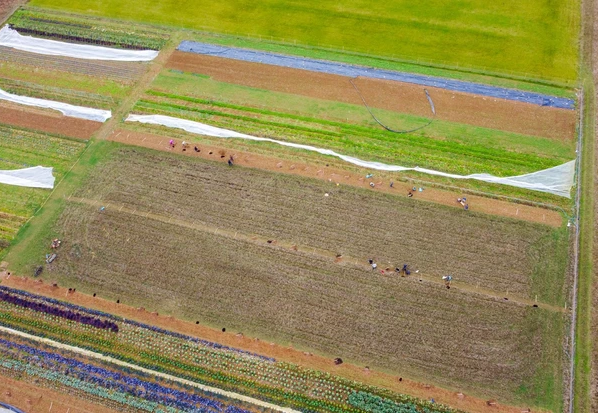
Trees were planted in a wave form with smaller rootstock on the southern edge and large standards on the north to minimise shading caused by the NE-SW orientation of the existing crop alleys.
Forest Garden
Small scale forest garden designed and planted in 1/4 acre vegetable garden.
Key Design Features
- Multi-layered planting design
- Tree layer: apple, plum, mulberry, strawberry tree, sea buckthorn, elaeagnus, pineapple guava, sumac
- Shrub layer: raspberry, black and red currant, jostaberry, japanese wine berry, bog myrtle
- Ground layer: strawberries, mint, wormwood, asparagus, chard, wild celery, lovage, echinacea, good king henry, salad burnet, comfrey, globe artichoke, cardoon, himalayan raspberry
- Vines: kiwi & grape
- Below ground layer: king stropharia fungi, jerusalem artichoke
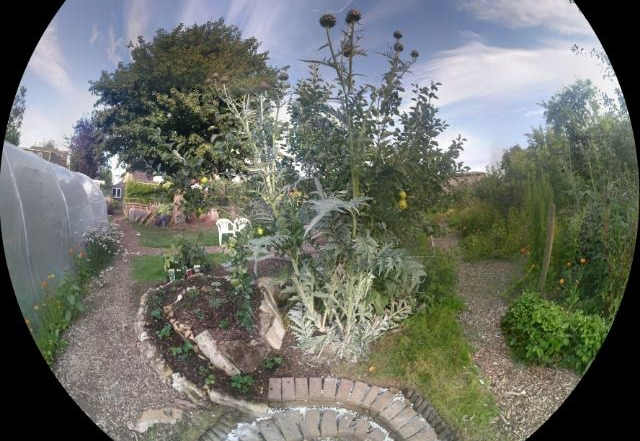
The forest garden produces a diversity of food products while also providing habitat for a variety of bees and other pollinators, frogs, birds and the occasional hedgehog.
EcoTree Agroforestry Design Pilot Project
Agroforestry designs produced for three UK farms as part of a pilot project in collaboration with EcoTree. Two of the three designs are to be implemented winter 2022/23.
Silvopasture Orchard & Contour Windbreaks (top)
- Pastured beef, lamb, and poultry farm in South Shropshire managed through holistic planned grazing.
- Browseable windbreaks placed on contour moderate slope to reduce erosion, improve water infiltration, and provide shelt from north-easterly winds.
- Four fenced-rows of top-fruit mixed with understory of soft fruits, with intention of integrating poultry within tree rows for weed management.
Silvoarable Fruit Alley Cropping (middle)
- Arable farming business planning to diversify into fruit juice production for local food system in Berkshire.
- 36m cropping alleys to fit sprayer widths.
- 6m tree rows undersown with legumes with 256 apple trees.
- North Easterly shelterbelt on 0.1 ha.
- Hybrid willow coppice block (340 trees) planted for future woodchip production for fruit trees.
Silvopasture Fruit Alley Cropping & Timber Alley Coppice (bottom)
- Pasture on family farm currently being extensively grazed by sheep.
- 100+ fruit trees (apple, pear, plum, damson, mirabelle, gage, mulberry, walnut) planted in 5m wide fenced tree rows.
- Timber Coppice Alley system adjacent to existing woodland featuring coppiced hazel, hybrid willow and poplar for woodchip and biochar production. Coppice blocks act as nurse trees for high value timber rows, including sweet chestnut and wild cherry amongst others.
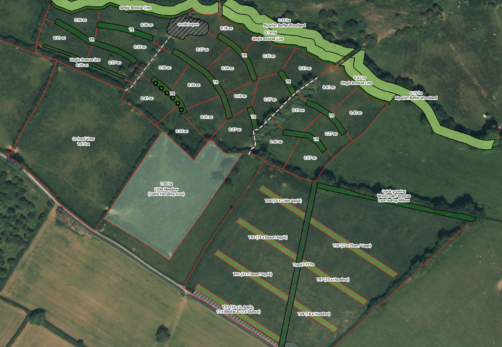
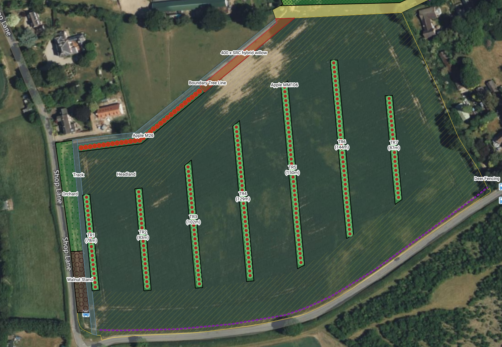

Whole Farm Agroforestry Plan
Visionary plan for whole farm silvopasture design created for Nicholson's Lockhart Garratt.
Key Design Features
- Browse Silvopasture Alley Cropping feat. coppice, timber, and fruiting hedgerows.
- Coppice to produce woodchip for winter-bedding and chestnut fence posts.
- Two woodpasture areas to provide shade and shelter for stock while enhancing habitat and food provision for wildlife.
- Walnut and willow living fence to deter flies and moderate wind around cattle housing.
- Full length shelterbelt to protect against winter winds and noise from motorway.

Silvoarable Concept Design
Concept design produced for fruit and nut production as part of a business diversification strategy for an Estate in Lincolnshire
Key Design Features
- Alley-cropping design analysis and species selection
- Fruit & Nut production alongside fruiting hedgerows for gin production
